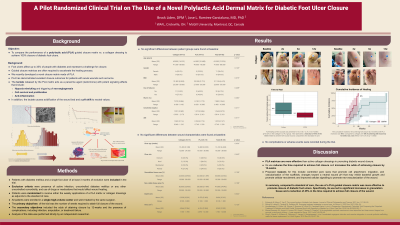Clinical Research
(CR-030 (GR-006)) A pilot randomized clinical trial on the use of a novel polylactic acid matrix for diabetic foot ulcer closure

Foot ulcers affect up to 35% of people with diabetes and represent a challenge for closure. Thus, guided closure matrices are often required to accelerate the healing process. Recently, a novel polylactic acid (PLA) closure matrix was developed. The objective of this study was to compare the time needed to achieve 100% closure of diabetic foot ulcers using this matrix compared to collagen dressings.
Methods:
Patients with diabetes mellitus and a single foot ulcer of at least three months of evolution were randomized to receive either the weekly applications of a PLA matrix or collagen dressings as adjuncts to the standard of care. The wound size, the percentage of granulation tissue area, the number of weeks required to attain full closure, and the presence of complications, including infection, amputation, or treatment failure, were recorded. All patients were enrolled in a single high-volume center and were treated by the same surgeon. Analysis of the data was performed blindly by an independent researcher.
Results:
A total of 31 patients were enrolled in the study (16 received PLA matrices and 15 collagen dressings). At baseline, the Hb1c, ABI, wound age, the percentage area of granulation tissue, and wound size were similar between the patient groups. All patients were followed until wound closure was attained. Granulation tissue area was dramatically increased in the PLA group, and the time needed to achieve full closure was 44% less in these patients compared to those in the collagen dressing group (9.3 ± 2.9 vs. 16.8 ± 8.1 weeks, p = 0.021). The cumulative incidence of healing by 12 weeks was 90% for the PLA group, compared to 30% in the collagen one. No complications were recorded during the trial.
Discussion:
PLA matrices are more effective than active collagen dressings in promoting diabetic foot ulcer closure. Proposed reasons for this include controlled pore sizes that promote cell attachment, migration, and vascularization of the scaffolds; changes toward a neutral wound pH that may inhibit bacterial growth and promote cellular recruitment; and improved cellular signalling to promote neo-vascularization of the wound.
Trademarked Items: SupraSDRM
References: 1. Edmonds M, Manu C, Vas P. The current burden of diabetic foot disease. Journal of Clinical Orthopaedics and Trauma. 2021 Jun 1;17:88–93.
2. Mirhaj M, Labbaf S, Tavakoli M, Seifalian AM. Emerging treatment strategies in wound care. Int Wound J. 2022 Nov;19(7):1934–54.
3. Hundeshagen G, Collins VN, Wurzer P, Sherman W, Voigt CD, Cambiaso-Daniel J, et al. A Prospective, Randomized, Controlled Trial Comparing the Outpatient Treatment of Pediatric and Adult Partial-Thickness Burns with Suprathel or Mepilex Ag. J Burn Care Res. 2018 Feb 20;39(2):261–7.
4. Blome-Eberwein SA, Amani H, Lozano DD, Gogal C, Boorse D, Pagella P. A bio-degradable synthetic membrane to treat superficial and deep second degree burn wounds in adults and children - 4 year experience. Burns. 2021 Jun;47(4):838–46.
5. Ring A, Goertz O, Al-Benna S, Ottomann C, Langer S, Steinstraesser L, et al. Accelerated angiogenic induction and vascular integration in a novel synthetic scaffolding matrix for tissue replacement. Int J Artif Organs. 2010 Dec;33(12):877–84.

.png)
